1983 Citroen BX 16TRS - For the love of cars!
Discussion
S100HP said:
Impressive, but how is the GT doing? 
The GT is trickling along. The key thing is the TRS is immobile at the moment, which isn't good from a workshop point of view. The GT runs and moves around, so the TRS is currently slightly higher priority.
No point rushing to finish GT before next spring now anyway, as my Dad wouldn't drive it in the salt after all that welding

Moar subfr4m3!!!
Yeah, it's pretty much there now. To pick up from the last update, all the metalwork and welding has been completed. I wasn't happy with the rot building up between the seams on the 'good' side, and I wasn't convinced that the rust-converter would work its way right inside, so I cut some little windows out to grind away the corrosion before it turned into something nastier in the future:
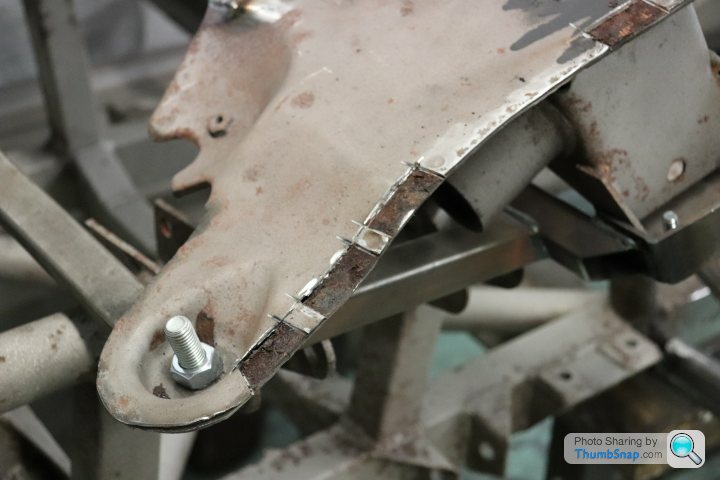
(Stuff like this is why I take FOREVER to finish jobs!)
Then it was welded and linished off, and eventually I had a solid mk1 BX subframe again:
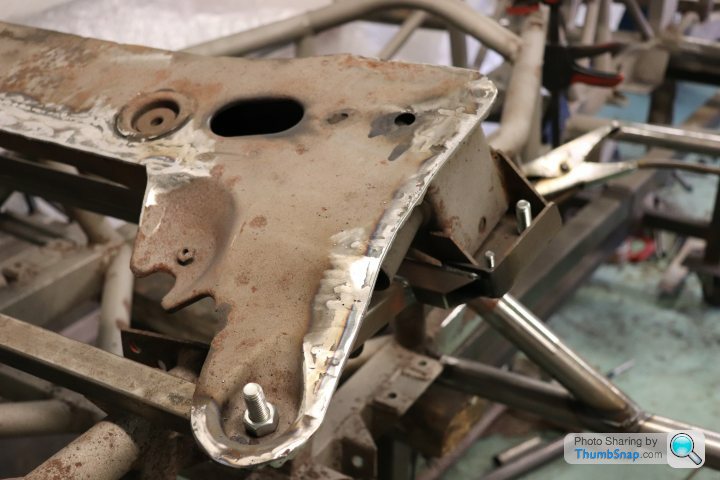
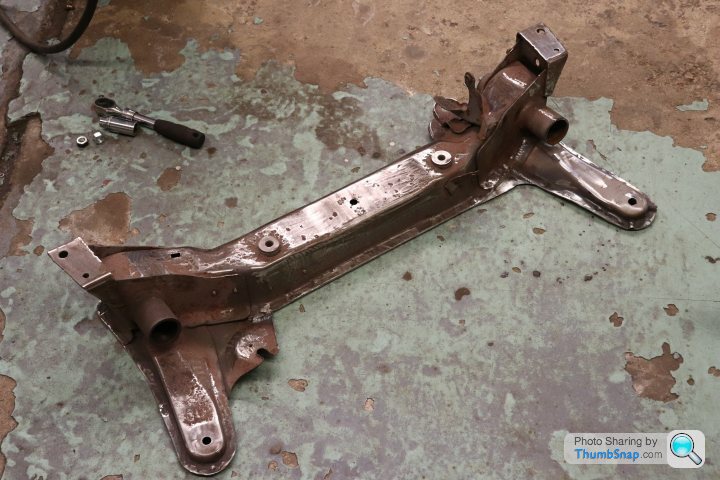
Once the welding was done, I attempted to rid it of the surface rust in our small-scale grit-blaster, but sadly it didn't really fit, and I only managed to re-blast about 50% of the subframe (mind you, it was the worst 50% at least). So, I applied a load of rust converter and had to delay painting for another 24hrs. It's worth it though - no point taking all this time and then rushing the last bit. Moral of the story? If you shotblast a subframe, don't leave it 2 years before you paint it!
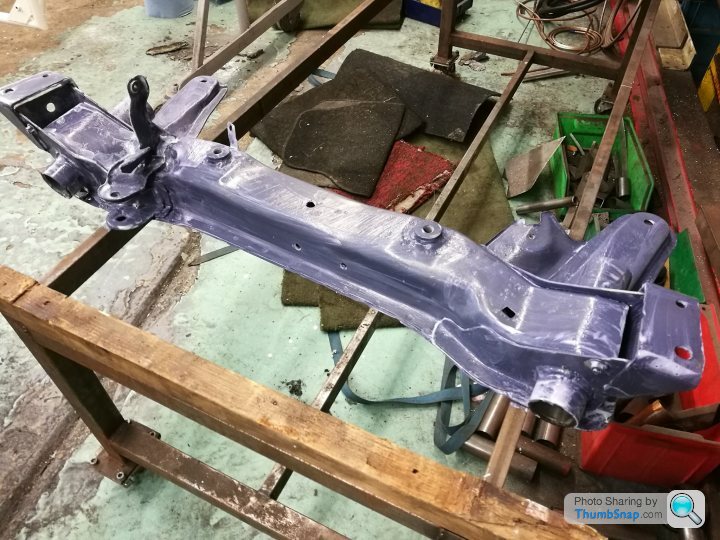
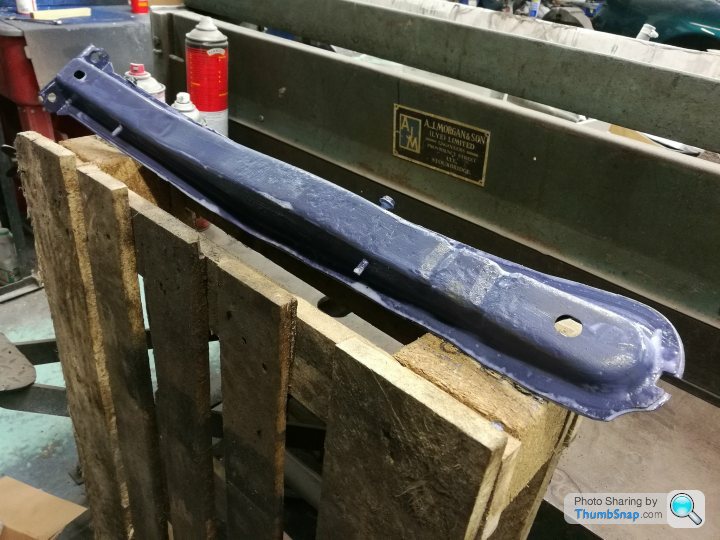
Once the treatment had finished, it was out with the paint. I went for something hardcore!:
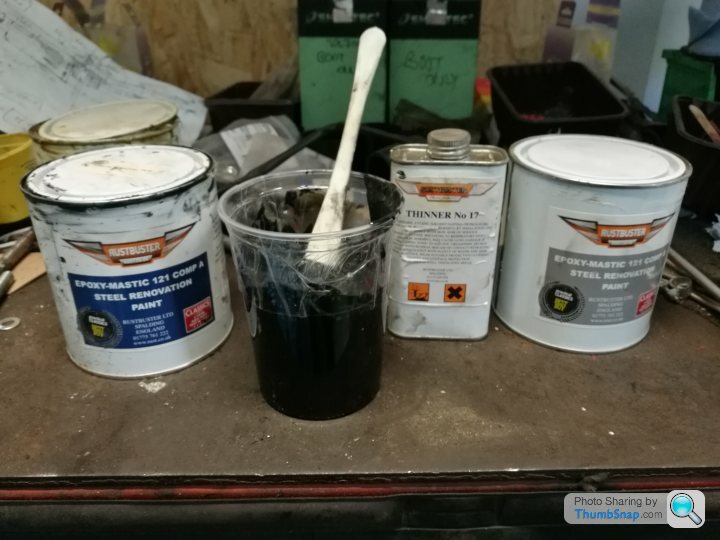
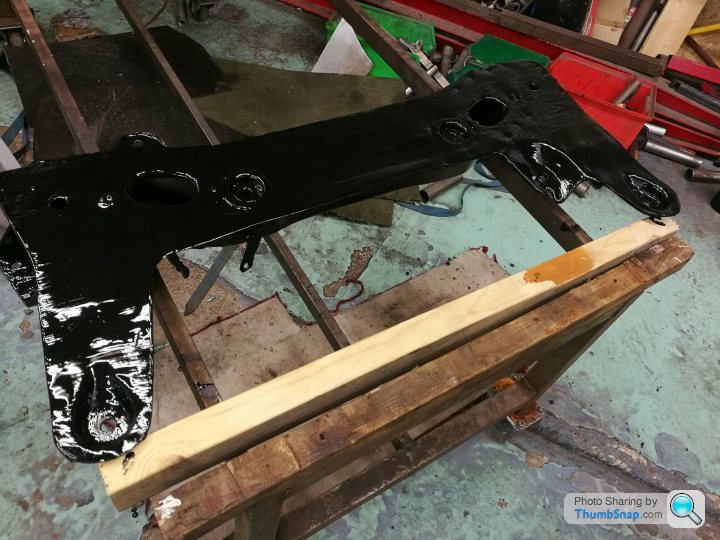
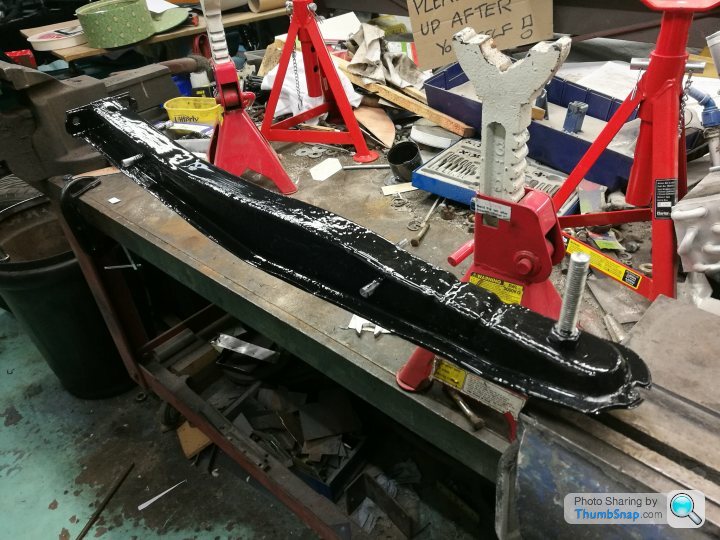
Once that's gone off (and it will....like concrete) I'll flat back the brush marks and give it a quick lick with some gloss black spray. Originally, this era of BX would have had a sort of dark-bronze/brown colour rust coating, but I've decided I'm not sufficiently arst to find a colour match!
I might actually be able to pick some spanners up on it soon!
Yeah, it's pretty much there now. To pick up from the last update, all the metalwork and welding has been completed. I wasn't happy with the rot building up between the seams on the 'good' side, and I wasn't convinced that the rust-converter would work its way right inside, so I cut some little windows out to grind away the corrosion before it turned into something nastier in the future:

(Stuff like this is why I take FOREVER to finish jobs!)
Then it was welded and linished off, and eventually I had a solid mk1 BX subframe again:


Once the welding was done, I attempted to rid it of the surface rust in our small-scale grit-blaster, but sadly it didn't really fit, and I only managed to re-blast about 50% of the subframe (mind you, it was the worst 50% at least). So, I applied a load of rust converter and had to delay painting for another 24hrs. It's worth it though - no point taking all this time and then rushing the last bit. Moral of the story? If you shotblast a subframe, don't leave it 2 years before you paint it!


Once the treatment had finished, it was out with the paint. I went for something hardcore!:



Once that's gone off (and it will....like concrete) I'll flat back the brush marks and give it a quick lick with some gloss black spray. Originally, this era of BX would have had a sort of dark-bronze/brown colour rust coating, but I've decided I'm not sufficiently arst to find a colour match!
I might actually be able to pick some spanners up on it soon!
The second-oldest known BX in the UK is 35 years old!
Seemed fitting to celebrate the fact that back in 1983, on this very day, our BX was assembled at Rennes, France. As close as you can have to a birthday!
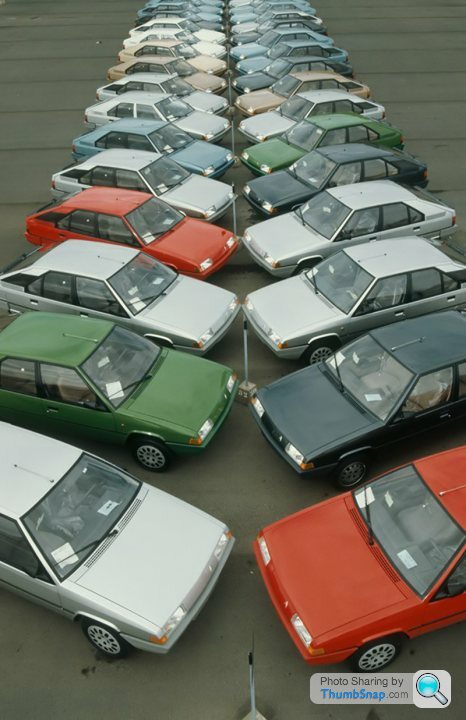
A bit of progress since the last update, which I'll post up as soon as I get a chance.
Seemed fitting to celebrate the fact that back in 1983, on this very day, our BX was assembled at Rennes, France. As close as you can have to a birthday!

A bit of progress since the last update, which I'll post up as soon as I get a chance.
Edited by Kitchski on Friday 30th November 11:10
OK, so an update didn't follow shortly after. In my defence, it hasn't quite been a year since the last post! Not far off though; the BX is 36 years old in a couple of weeks!
I've had so much going on (as we all do) that any spare time available on the old crock has been sparse at best. But, a workshop move-around prompted things to get moving again a little while ago, and I'm now moving on where I left off. I wouldn't say I was charging forward...more ticking over, but I've left it in gear.
One of the first things I needed to sort out for this car, was another car. A donor car, in fact. Sad as it is to do it, the reality is that I will likely need quite a few parts over the course of this project (and another BX project that I'm doing...a thread on that to follow!) So it's a case of one car dies, but it saves two others, which would have otherwise been dead too.
Enter E574 MYR!
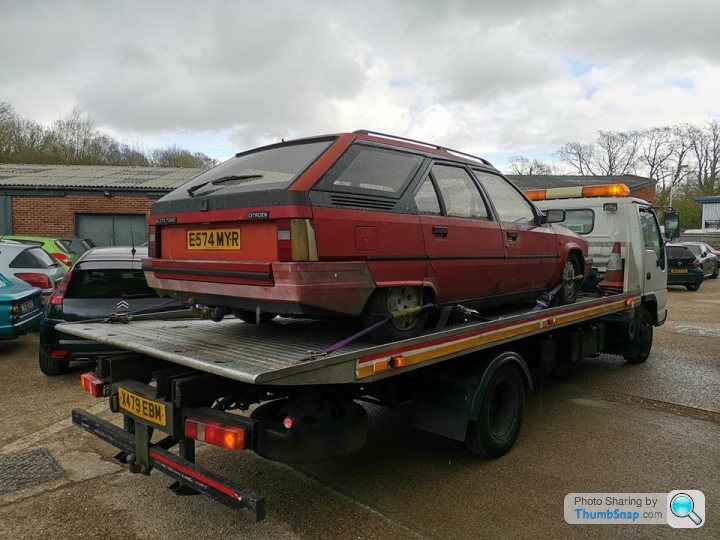
It pains me a little to do this, but here is £50's worth of BX. 200k miles on the clock; an engine that smokes and loses fuel, and sills that are made of air.
It still pains me, however, as it's a pretty rare BX; an early turbo diesel estate specced as the 'DTR Turbo'. Effectively, it's an early GTi-specification car, but with a TD engine. The DTR Turbo was the TD version of the TRS. Why wasn't it called the TRD Turbo? They are, anywhere but English-speaking countries, but here, TRD looks like 'turd'!
The DTR was replaced by the TZD Turbo, which is a trim lots of previous owners will likely recognise. Basically, it was one of the first plush turbo-diesel French cars; Cars that began the diesel invasion of the 1980's. Bow down to, or lambast it as you see fit...
Probably less than ten of these left now, and it's going to be one less.
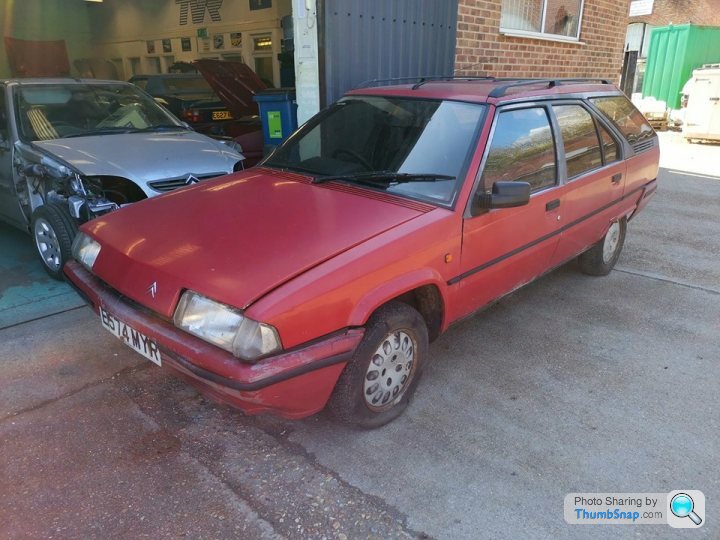
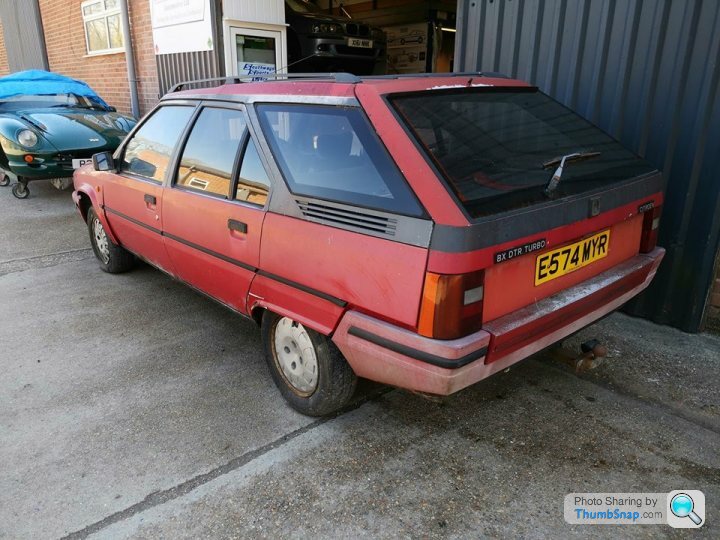
As mentioned, it is very rotten, and in most places...except one of the most common places for an estate: The rear arches. You see, the estate BXs weren't actually built by Citroen, they were assembled in Rorthais by Heuliez. As a result, rust protection wasn't quite as tough as on the hatchbacks! But, there is a reason I needed estate rear arches...
You see, in BX-land, there are mk1 and mk2 cars (which many of you probably know).
Mk1 (1982 - 1986):
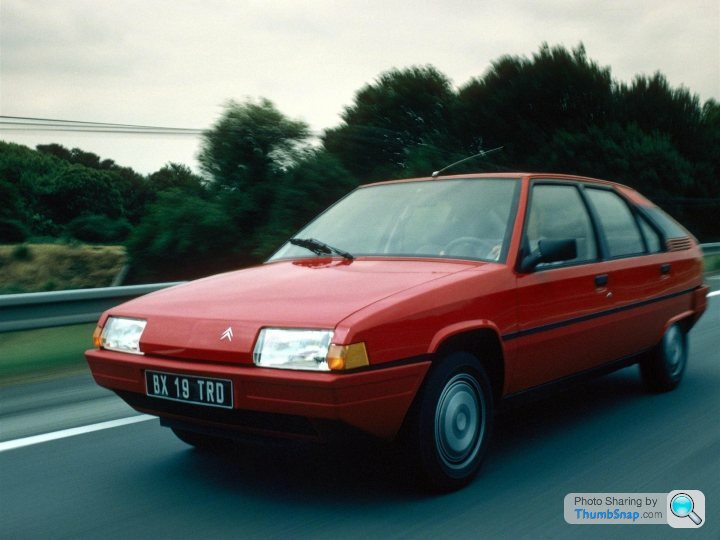
Mk2 (1986 - 1994):
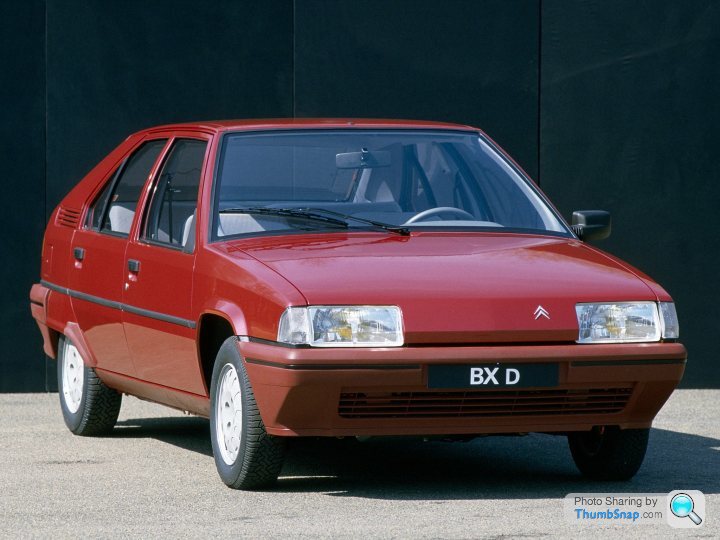
There are plenty of differences, such as the shape of the bumpers; The amber small front indicator vs. the larger clear one; The door mirrors; The dashboard (mk1 had the rocker switch indicators, while the mk2 was a bit more conventional (because people minced about the earlier car). There were plenty of differences, but one of the ones that many people don't spot, are the wheel arches. They're the same shape, but the mk1 has slimmer arches; The mk2's were more flared, presumably to make it look a little more aggressive/conventional, or possibly because they knew wider alloy wheels would be needed (the only mk1s with wider alloy wheels were the Sport and 4TC, and neither had regular wheel arches!)
However, nobody thought to tell Heuliez!*
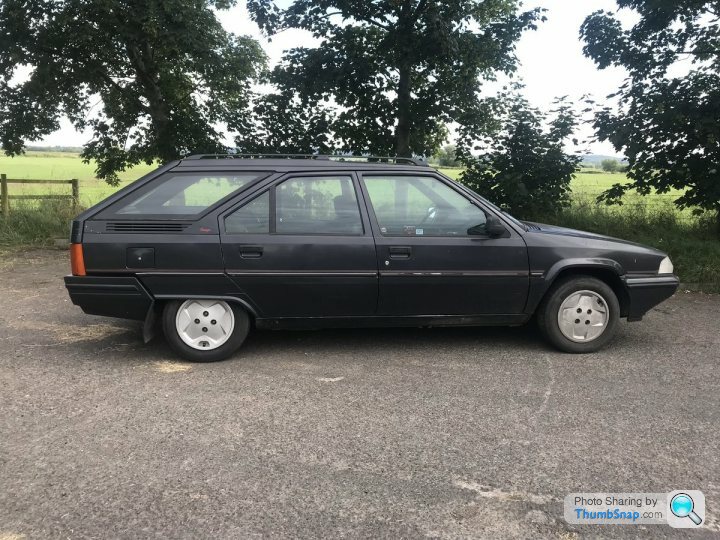
Mk1 rear...mk2 front!
*Well, they probably did, and there were probably plenty of communications between designers, engineers and senior bods from each company, with various meetings at boardroom level and detailed analysis of the wheres and whys and why nots and...stuff. I'm guessing it wasn't an accident, I just don't know the reason why the estate never received the mk2 rear arches. Maybe Heuliez wanted to charge more to make new pressings...who knows! Someone, I expect, but there's no jeopardy or lolz in that, so we'll just assume Heuliez forgot because they were drunk on wine and cheese. No wait, is that racist? I'm not sure. I don't think it is. It's like suggesting Parisians are romantic, or Italians passionate, or Germans....just..., well, German. I'm waffling now, but I'm guessing you worked that out.
So, here are the mk1...no, mk2...well, it is a mk2, but it's an estate, so...it's like a mk1.5? Well no, I suppose it's not, because that would insinuate the arches made up 50% of what constitutes a mk1 or mk2, and they don't, as I outlined above. I guess I'll need to break the car down mathmatically, and figure out what ratio of a BX constitutes it being a mk1 or mk2, and get back to you with an amended 'mk' number.
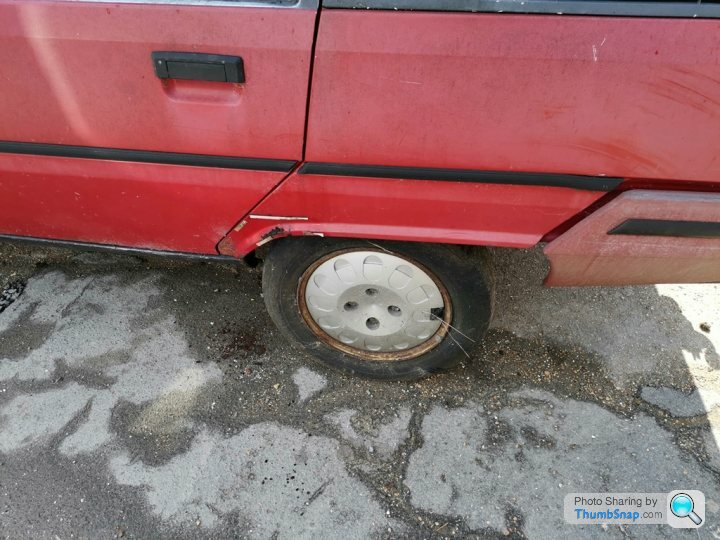
So, rather unusually, these are in pretty good order, which is more than can be said for my TRS...
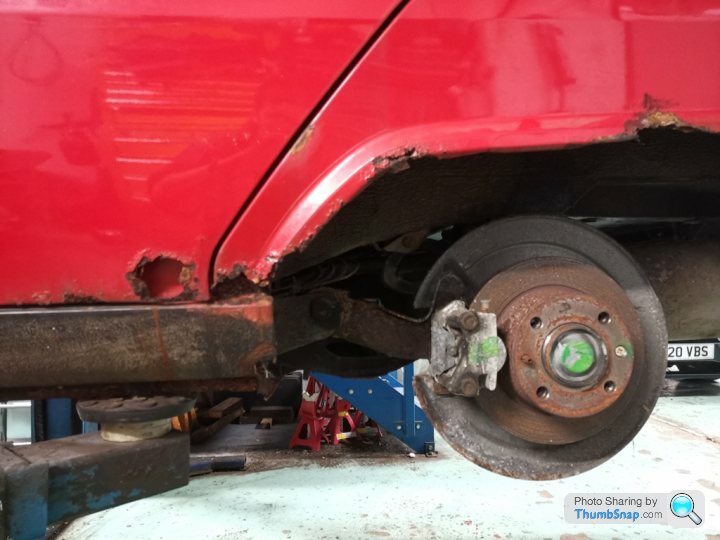
And, because I've spent so long t ttering on about cheese, wine and racism, I've run out of time to say what I was going to say, but it's technical geekery and refurbishing old stuff. I'll have to pick it up tomorrow or something!
ttering on about cheese, wine and racism, I've run out of time to say what I was going to say, but it's technical geekery and refurbishing old stuff. I'll have to pick it up tomorrow or something!
I'm not stoned, honestly! It's just how my mind works, and its tiring!
I've had so much going on (as we all do) that any spare time available on the old crock has been sparse at best. But, a workshop move-around prompted things to get moving again a little while ago, and I'm now moving on where I left off. I wouldn't say I was charging forward...more ticking over, but I've left it in gear.
One of the first things I needed to sort out for this car, was another car. A donor car, in fact. Sad as it is to do it, the reality is that I will likely need quite a few parts over the course of this project (and another BX project that I'm doing...a thread on that to follow!) So it's a case of one car dies, but it saves two others, which would have otherwise been dead too.
Enter E574 MYR!

It pains me a little to do this, but here is £50's worth of BX. 200k miles on the clock; an engine that smokes and loses fuel, and sills that are made of air.
It still pains me, however, as it's a pretty rare BX; an early turbo diesel estate specced as the 'DTR Turbo'. Effectively, it's an early GTi-specification car, but with a TD engine. The DTR Turbo was the TD version of the TRS. Why wasn't it called the TRD Turbo? They are, anywhere but English-speaking countries, but here, TRD looks like 'turd'!
The DTR was replaced by the TZD Turbo, which is a trim lots of previous owners will likely recognise. Basically, it was one of the first plush turbo-diesel French cars; Cars that began the diesel invasion of the 1980's. Bow down to, or lambast it as you see fit...
Probably less than ten of these left now, and it's going to be one less.


As mentioned, it is very rotten, and in most places...except one of the most common places for an estate: The rear arches. You see, the estate BXs weren't actually built by Citroen, they were assembled in Rorthais by Heuliez. As a result, rust protection wasn't quite as tough as on the hatchbacks! But, there is a reason I needed estate rear arches...
You see, in BX-land, there are mk1 and mk2 cars (which many of you probably know).
Mk1 (1982 - 1986):

Mk2 (1986 - 1994):

There are plenty of differences, such as the shape of the bumpers; The amber small front indicator vs. the larger clear one; The door mirrors; The dashboard (mk1 had the rocker switch indicators, while the mk2 was a bit more conventional (because people minced about the earlier car). There were plenty of differences, but one of the ones that many people don't spot, are the wheel arches. They're the same shape, but the mk1 has slimmer arches; The mk2's were more flared, presumably to make it look a little more aggressive/conventional, or possibly because they knew wider alloy wheels would be needed (the only mk1s with wider alloy wheels were the Sport and 4TC, and neither had regular wheel arches!)
However, nobody thought to tell Heuliez!*

Mk1 rear...mk2 front!
*Well, they probably did, and there were probably plenty of communications between designers, engineers and senior bods from each company, with various meetings at boardroom level and detailed analysis of the wheres and whys and why nots and...stuff. I'm guessing it wasn't an accident, I just don't know the reason why the estate never received the mk2 rear arches. Maybe Heuliez wanted to charge more to make new pressings...who knows! Someone, I expect, but there's no jeopardy or lolz in that, so we'll just assume Heuliez forgot because they were drunk on wine and cheese. No wait, is that racist? I'm not sure. I don't think it is. It's like suggesting Parisians are romantic, or Italians passionate, or Germans....just..., well, German. I'm waffling now, but I'm guessing you worked that out.
So, here are the mk1...no, mk2...well, it is a mk2, but it's an estate, so...it's like a mk1.5? Well no, I suppose it's not, because that would insinuate the arches made up 50% of what constitutes a mk1 or mk2, and they don't, as I outlined above. I guess I'll need to break the car down mathmatically, and figure out what ratio of a BX constitutes it being a mk1 or mk2, and get back to you with an amended 'mk' number.

So, rather unusually, these are in pretty good order, which is more than can be said for my TRS...

And, because I've spent so long t
 ttering on about cheese, wine and racism, I've run out of time to say what I was going to say, but it's technical geekery and refurbishing old stuff. I'll have to pick it up tomorrow or something!
ttering on about cheese, wine and racism, I've run out of time to say what I was going to say, but it's technical geekery and refurbishing old stuff. I'll have to pick it up tomorrow or something!I'm not stoned, honestly! It's just how my mind works, and its tiring!
Kitchski said:
Enter E574 MYR!

It pains me a little to do this, but here is £50's worth of BX. 200k miles on the clock; an engine that smokes and loses fuel, and sills that are made of air.
It still pains me, however, as it's a pretty rare BX; an early turbo diesel estate specced as the 'DTR Turbo'. Effectively, it's an early GTi-specification car, but with a TD engine. The DTR Turbo was the TD version of the TRS.
That is **exactly** what my parents had. Same colour and everything. 
It pains me a little to do this, but here is £50's worth of BX. 200k miles on the clock; an engine that smokes and loses fuel, and sills that are made of air.
It still pains me, however, as it's a pretty rare BX; an early turbo diesel estate specced as the 'DTR Turbo'. Effectively, it's an early GTi-specification car, but with a TD engine. The DTR Turbo was the TD version of the TRS.
That is **exactly** what my parents had, and then I had as my "first" car! F450GNA. Red.
Could fit a single mattress in the boot with the seats down, which was handy as a 17yo with a new g/f...When it was working, which was often not. That car gave me some trouble, usually when I was on my way out to a mate's for a night out. I think I blew all of the core plugs and several hoses over the 18mo I had it.
I think I blew all of the core plugs and several hoses over the 18mo I had it.
Could fit a single mattress in the boot with the seats down, which was handy as a 17yo with a new g/f...When it was working, which was often not. That car gave me some trouble, usually when I was on my way out to a mate's for a night out.
 I think I blew all of the core plugs and several hoses over the 18mo I had it.
I think I blew all of the core plugs and several hoses over the 18mo I had it.An update on the rattly old red rotbox is well overdue, mostly on account of the fact I started it a couple of months ago, but never actually finished it!
(apologies if this is a bit hap-hazardly written, as I'm filling it in inbetween actually working!)
Anyway, I'm pleased to report things with the BX TRS are good. There have been some ups and downs (including the suspension), but on the whole, it's been a positive period.
So, back in October, I was still pratting around with that front subframe (did I mention it's a rare one?! Oh.) The fabrication and repair work was now done, but as it sat, it was a bare subframe, and that wouldn't be much use. I therefore decided to repopulate it with the various componentry that used to live there.
The bearings were already in place, but I knew the most time consuming piece was going to be the pipework. Despite my line of work as a sort-of-restoration-guy, I hadn't done much pipework on Citroens before. It was one area I'd never really had to address in all the years of knobbing about with them, but, I'd repiped the brake, clutch and fuel circuits on plenty of TVRs, so I figured that as the Citroen flares are normally easier to do, and the pipe thinner, that it should be a piece of cake in comparison. And, it was! Sorry, no jeopardy here.
To begin with the pipework, I needed to have ready all the components the pipework routed to. As this BX doesn't have power-steering (a blessing to my timescales), I didn't have quite as much fart around with as I otherwise might have done. But, I did have the majority of pipes to sort, as most of the originals were rotten clean through...or away entirely!
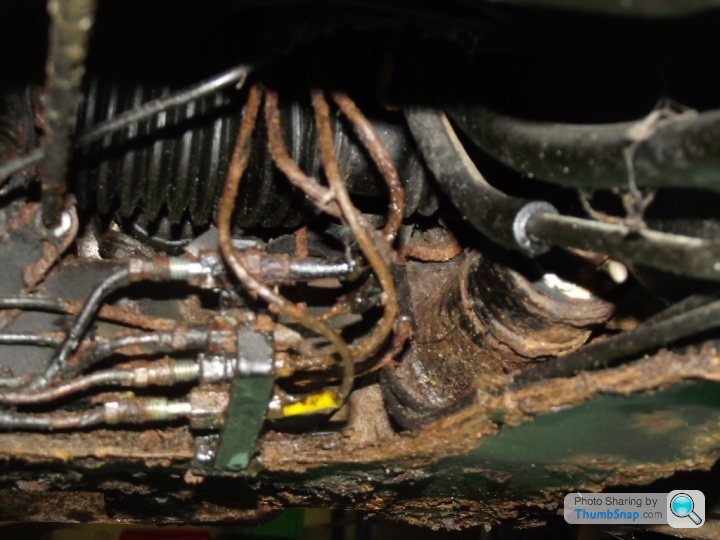
Later BXs used a black plastic coating around the pipework for added corrosion resistance, but earlier cars like this mk1 made do with bare steel. It was a good quality steel, sure, but it was steel all the same. The blustery Welsh coastline had clearly proven too much!
But now, it was time to start getting dirty, rusted parts of unknown servicability (that I'd removed about 3-4 years ago) together, and seeing what went where!
The first part, was the hydraulic safety/security valve. On a hydropneumatic Citroen, the majority of the system is simply hydraulic. The pneumatic element only comes into play when you get as far as the springing of the car, so unless you're dealing with spheres, it's hydraulic.
Everybody seems to act like they're too complicated, but that's only if you're ignorant. If I can grasp it, anybody can grasp it! Some green blood (aka LHM) sits in a reservoir (a round green metal one mounted in the offside inner wing), where it is drawn through a rubber hose by the high-pressure pump, and compressed until it's very, very fizzy (about 1400psi fizzy).
Once it's fizzed up, it's directed through a large-bore (6.5mm I.D.) metal pipe. On a car with power steering, it goes through a priority valve for this first, but being as this car doesn't have that, we'll keep it simple! So, at the other end of this metal pipe, is the pressure regulator (the thing that goes pssshhhh-tick every so often). This sits on front of the gearbox, and has a green sphere (or rust-coloured sphere, in my case) screwed onto it, like you would an oil filter. The pressure regulator allows the pressurised LHM through a small port and into the sphere. The sphere itself is very similar to that you'd find on end of one of the wheels, but its role is slightly different; It's basically a small but very strong balloon!
Imagine you have a generic balloon, the mouth of which is inserted onto a tube to allow the balloon to exhale. There's no knot, just your finger and thumb acting as a human 'tap' (so you could release it slightly and let the balloon down....and make funny squeaking noises!) But in this case, rather than blowing it up conventionally, it's got it's own supply for the air you pump, which goes in somewhere else, not the mouth of the balloon. So, the following alternative theory isn't exactly how it works, but it's the simplest way to imagine it (making this up as I go along):
However...there are also four smaller balloons in each corner of the room, which are all at the end of the pipe your balloon is stretched onto, and they also need to be regulated to a certain size. You have to inflate those by momentarily releasing and then reapplying your grip on your balloon, which in turn inflates those balloons a bit (and makes a 'psshhh-tick' noise), but of course, that also flattens your balloon in the process.
Annoyingly, every now and then, someone who calls themself Mr Bump comes along and tries to jump on those four balloons, at completely random intervals. What a knob! So now, you're probably going to have to keep pumping more often, and releasing pressure when you need to. How tiring!
And then, on top of this, there are four whistles. For some reason, these whistles are deemed to be very important, and although nobody is jumping on them, you are told that, occassionally, these whistles need to...well, whistle, and loudly! You don't have to worry about operating them, but you do have to make sure they have a sufficient supply of air that they'll actually make a noise when somebody else does.
So now, your easy job has become complicated. Your boss has come along and informed you that, to help, they'll divert the pressure to the whistles and the four balloons independantly, so that one doesn't affect the other too much. All you need to do is keep the pressure up.
However, if you don't keep the pressure up, the boss is going to stand on the pipe that goes to the whistles (so that they hold pressure briefly long enough to be blown for a short while longer), and forgets about the pipe that goes to the four balloons. These go flat, and the idiot Mr Bump can jump on the hard ground as much as he wants.
Then the boss informs EVERYBODY that you've let the pressure down, with a big red stop light.
I'm not smoking something, honest! That's just the easiest way to imagine it. I might go and give the pump and the regulator a quick cuddle now...that's a quite a s t life
t life 
Anyway, back to reality, and this little valve is the first port of call from the green blood, once it's been whizzed up to around 1400psi, and released by the pressure regulator.
There's a sprung valve inside, which requires a minimum set pressure to operate (the minimum set pressure the car can operate). If the pressure coming from the regulator (which on a healthy system has pretty much just been stored in the accumulator sphere) is sufficient, the spring is overpowered, and the valve remains open to both the brake and suspension circuits. Happy days.
However, if there is a drop in pressure (due to the engine dying and the pump stopping as a result, for example) as soon as it becomes lower than the pressure of the circuit, the valve slams shut and isolates the pressure in the braking circuit with everything that the accumulator had left. It also throws on the STOP light (which is what the little sensor is for). So, if you lose the engine, or the hydraulic input from the pump/regulator, maybe even down to a snapped belt, you've still got enough braking pressure left to halt the car safely. The suspension has to make do with whatever it had left, but a bumpy car you can stop is better than a smooth car that you can't.
So, let's meet the little valve (aka The Boss):
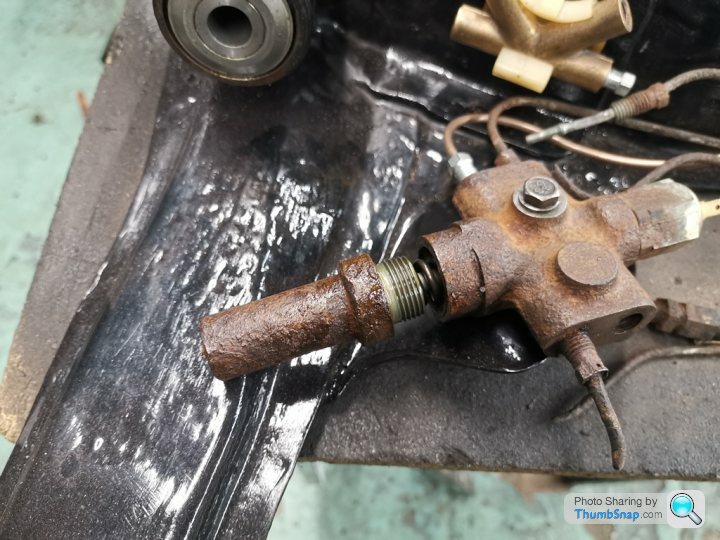
In this image, I've unwound the cap that holds the spring in position, and with it removed (having retreived the spring after it shot off across the workshop at tremendous speed):
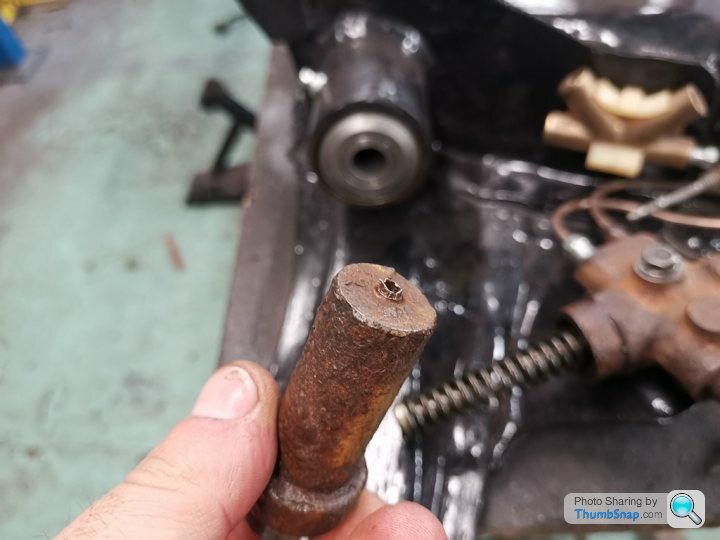
Now, it's all manky and rusty because the wicked Welsh climate has had its wicked way with it over the past three decades, but as you can see, there is a hole in the top. That isn't actually meant to be a hole, it's meant to be a spigot. There is still a hosetail for this spigot, but sadly it's lodged in the end of a very old and brittle rubber hose. Balls.
The purpose of the hose is a return to the reservoir. Anything the safety valve deems unneccessary goes back to the tank (or onto your driveway, if you've got a leaky hose).
Citroens have long utilised this design, which CX, GS and even DS models employing a near-identical component, but during the time of the BX's reign, some clever dick suggested they used a strong type of plastic for the cap instead, as that wouldn't rust. And, they were right; they didn't. But, the plastic looks wrong for an early BX, and being the anal sort that I am, I decided I wanted to keep it looking OE. I put a call to arms out in the Citroen community, but I didn't have much patience (not that any offers came back anyway). Loath to fit one of my plastic spares, I set about repairing the old one. That's the whole ethos of this car - repair and reuse, not replace. I want it as original as possible.
To put this into effect, I went routing around in some old boxes, and found this old hosetail, pictured on the left:
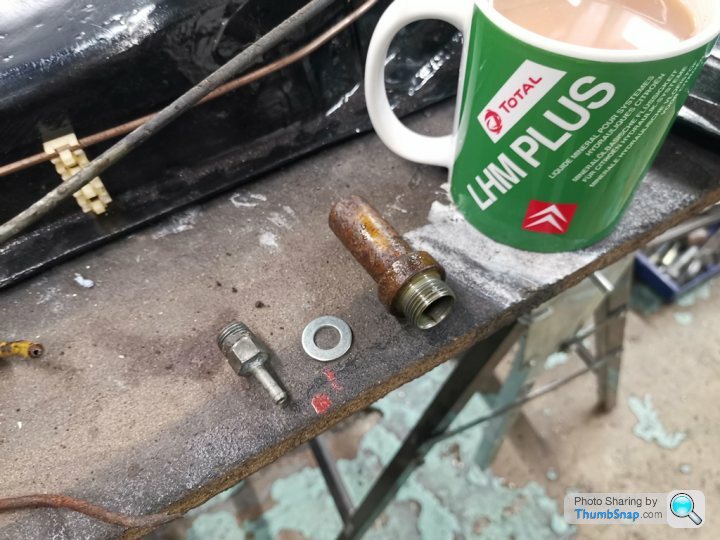
The cup of tea isn't relevant, that was just...I was thirsty.
The washer is relevant, though. The metal cap had rusted and lost a lot of weight at the end. The sides were a bit pitted, but still plenty tough enough. The end, though? I wasn't totally confident the spring wouldn't just pierce through the end! That's where the washer came in.
I drilled out the rusted remains of the original spigot, so that the replacement would fit through the hole snugly...
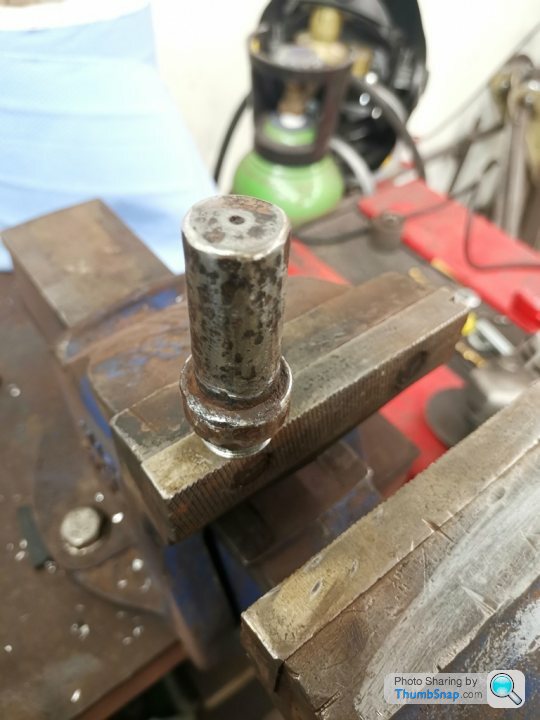
Then I cut down the hose tail until it was almost just a pipe! I left a bit on the end to locate in the hole in the cap:
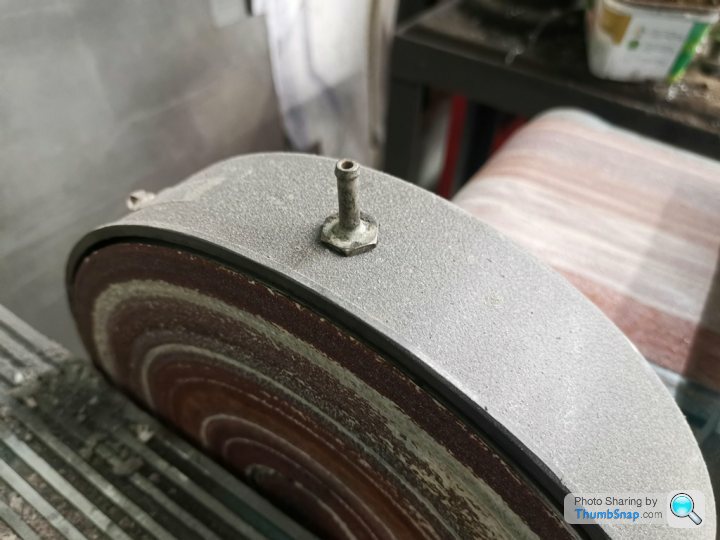
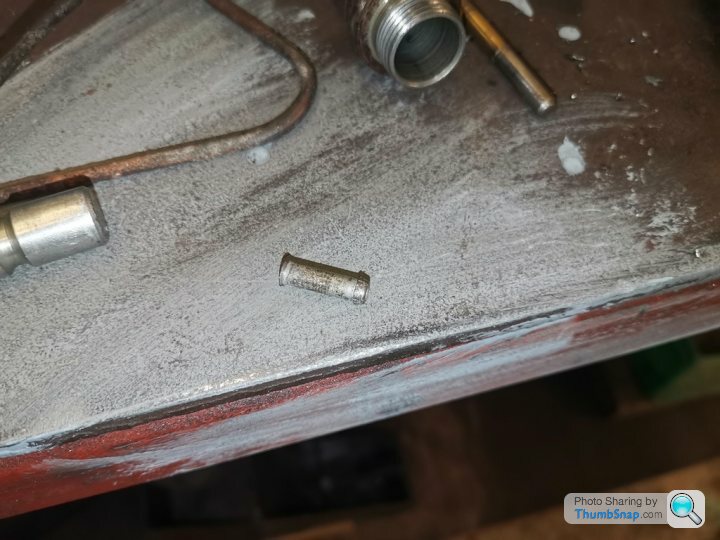
Then, I pushed it through the hole from the bottom, and clamped the new spigot in place:
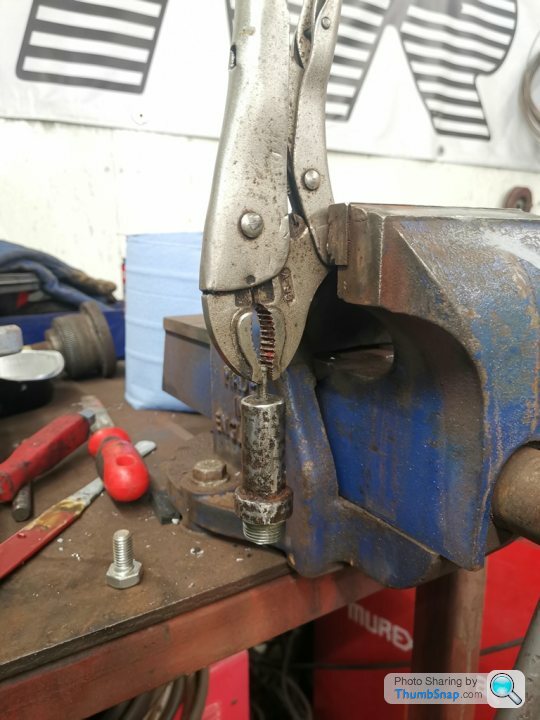
A quick tack-weld later:
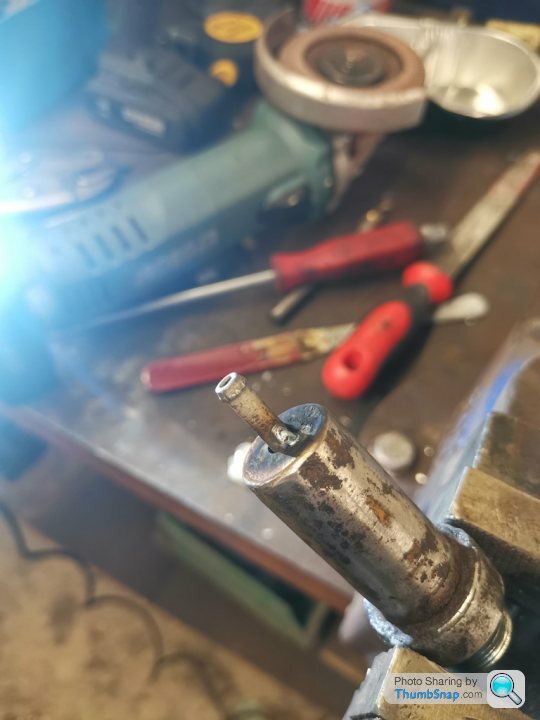
Then the washer came into play, to give it some strength back:
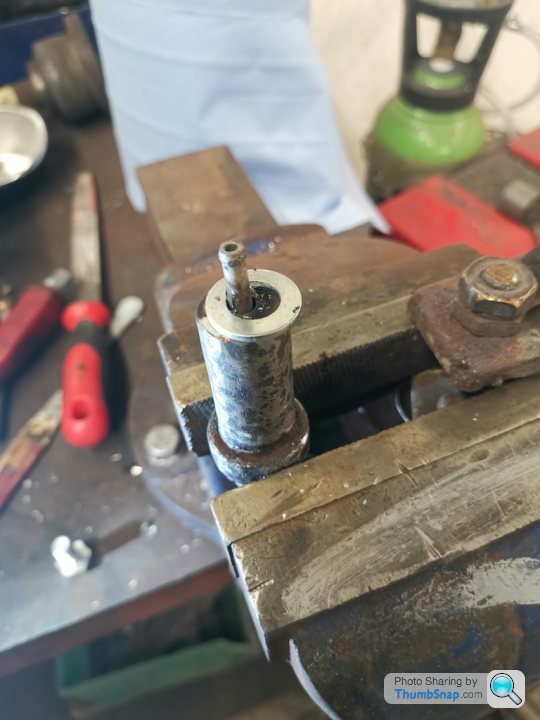
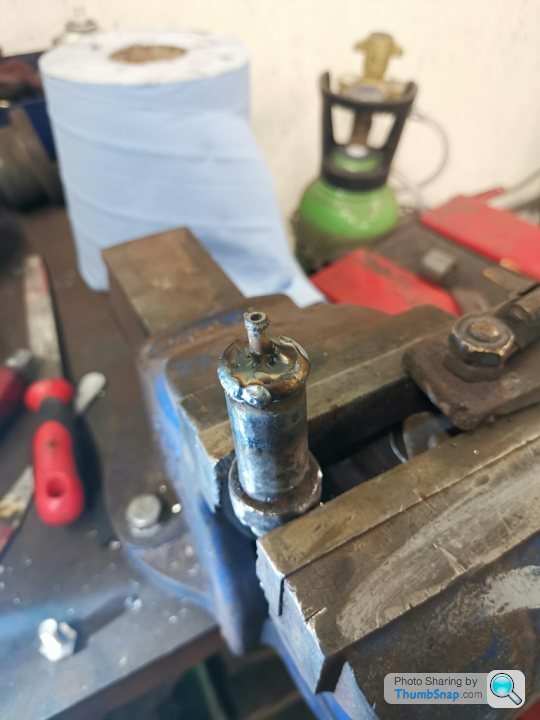
Seems like a lot of work for such a small component on an old car, doesn't it?!
Anyway, some primer later...:
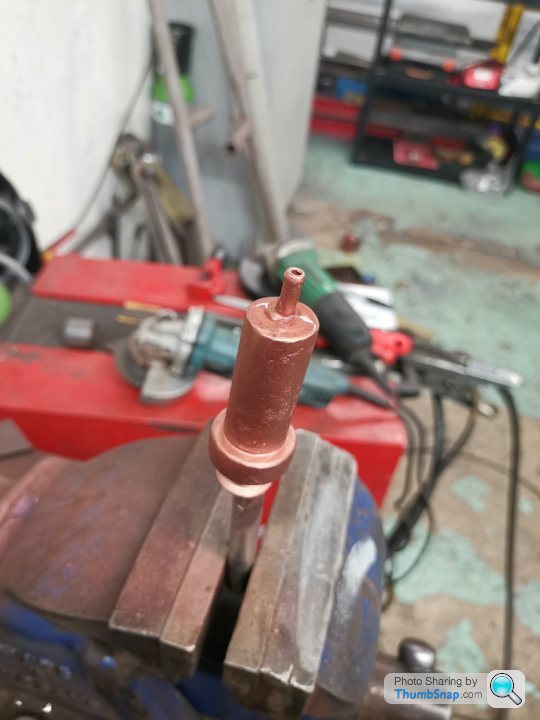
And it was ready for many coats of not-quite-Citroen's-original-LHM-green-but-something-close-to-it-from-the-RAL-chart:
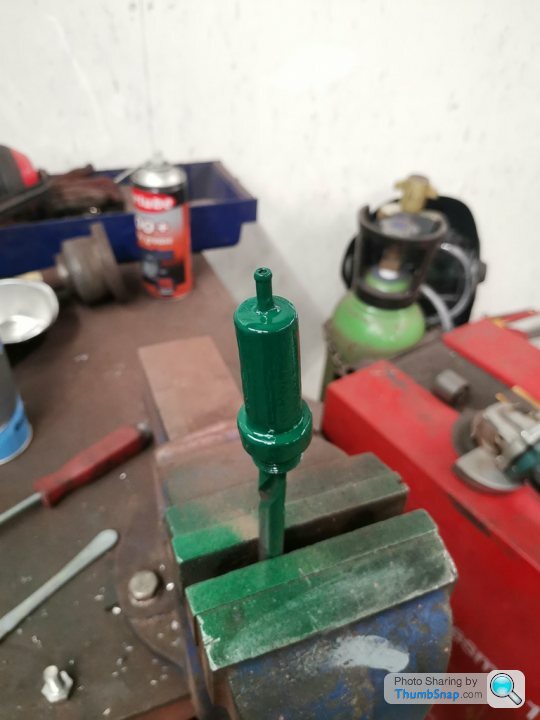
With the security valve reassembled and painted, I realised there weere other items that needed attention. I've also just realised that I've lost some pictures, so cannot document the new 'hardy' disc (rubber coupling between steering column and rack) that I fitted, or the cleaned up height-corrector, or the cleaned up steering rack....there's loads.
Anyway, in this image, you can see the old rack boots had been removed, the racks cleaned and greased, and the new hardy disc just visible near the top. The old one had totally split!
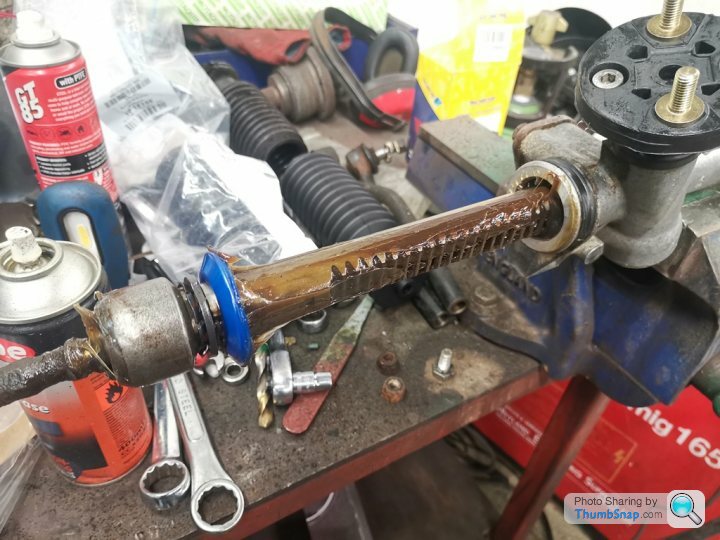
And in the meantime, I'd received new OMGcarpartsindapostgoodness from Autodoc, which is always a nice thing. It's the closest thing we have to the memories of unwrapping gifts at Christmas time as an excited child.
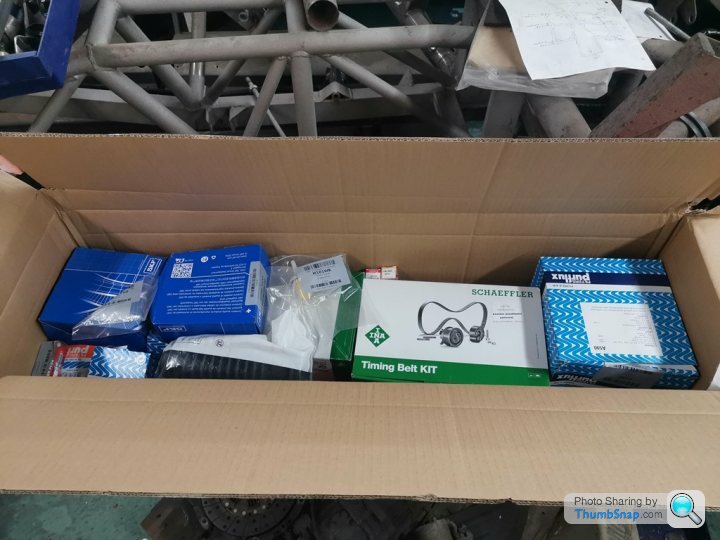
The new steering rack boots were contained within, along with a sum total of parts amounting to 180% more than I'd paid for the car.
This included:
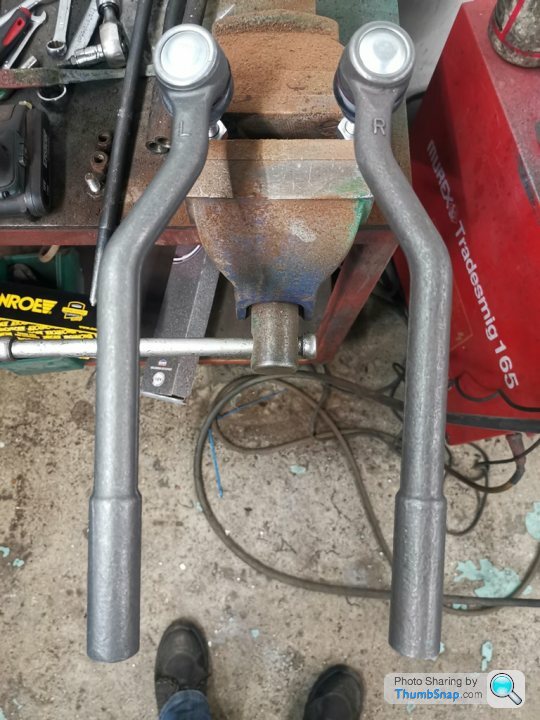
Track rod ends! My intentions had always been to hunt out the OEM options for any spare parts for this car, and Autodoc is a great site to do that on. Luckily, my BX is a great car to do that on, too, as the majority of it is as it left the line at Rennes! This means I know, for example, that the OEM for the steering rack boots was Continental.
Now, the track rod ends weren't yielding any clues, and they may well not have been original anyway, but I put my old partsman hat back on, and went for the best available brand I could. In this case, it was Monroe (or, what purported to be Monroe - you never know these days, like with Pagid or TRW). Given the options (and given that I discovered that First Line's supplier is the same as Sasic - I avoided those!), Monroe was the best of a bad bunch.
I had a phone call from a German fellow a day later, asking "Vot iz diz peace of sheet you arrgh buying diz part vor?" Not really, he didn't.
He said that there was only one Monroe part in stock, and that the opposite side would have to be a different brand. I took a punt on an 'ABS' item, and got a partial refund. When they arrived, I was elated to discover that they were, in fact, the same part! Happy days!
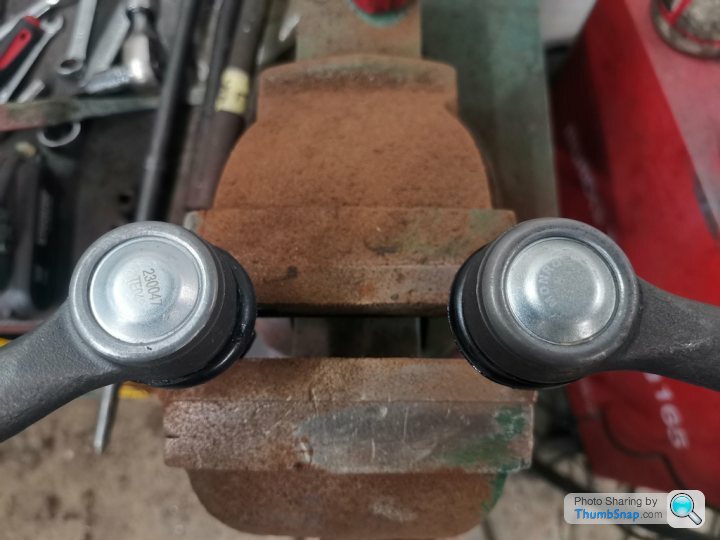
These were duly painted in my magic gloss black stuff that I paint pretty much anything I come into contact with:
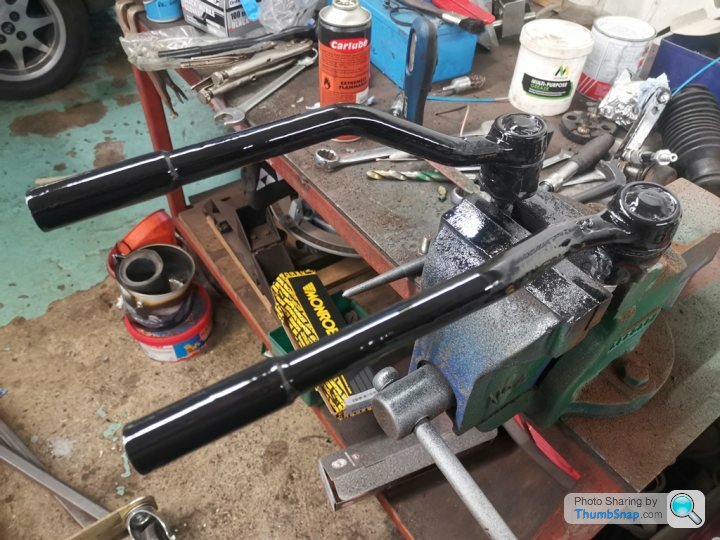
And eventually, all my work on this b d subframe culminated in something I could actually use!
d subframe culminated in something I could actually use!
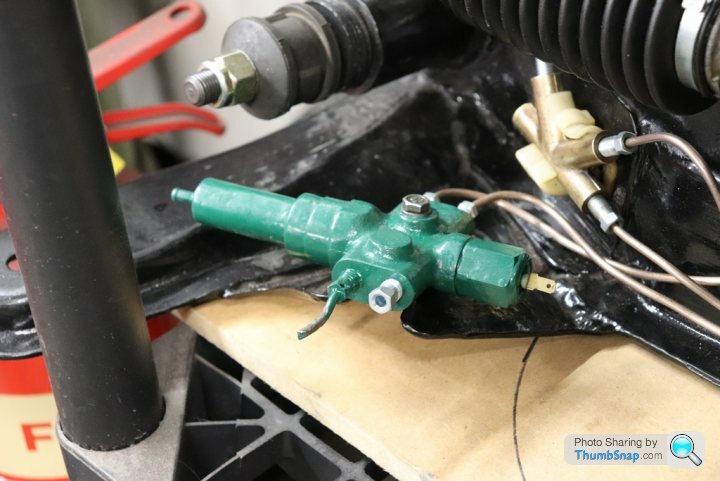
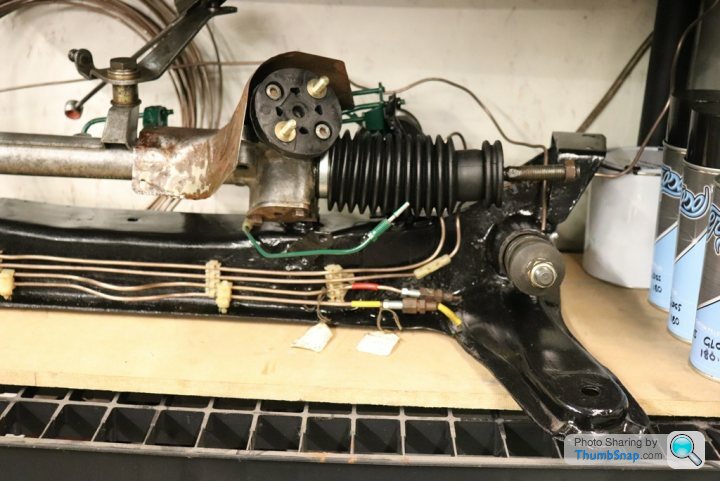
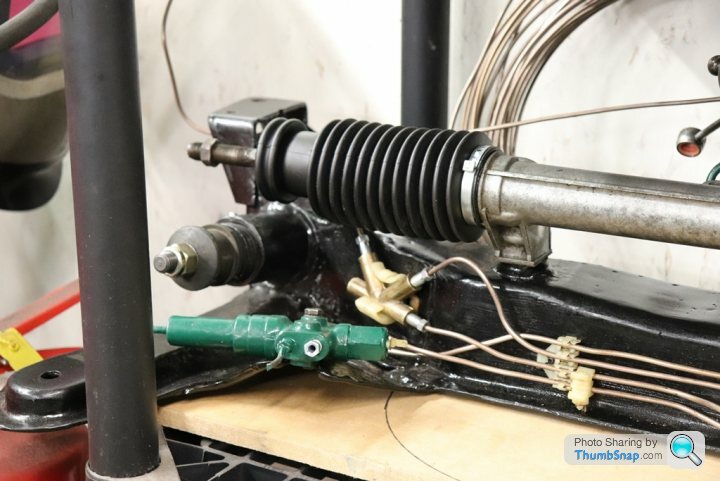
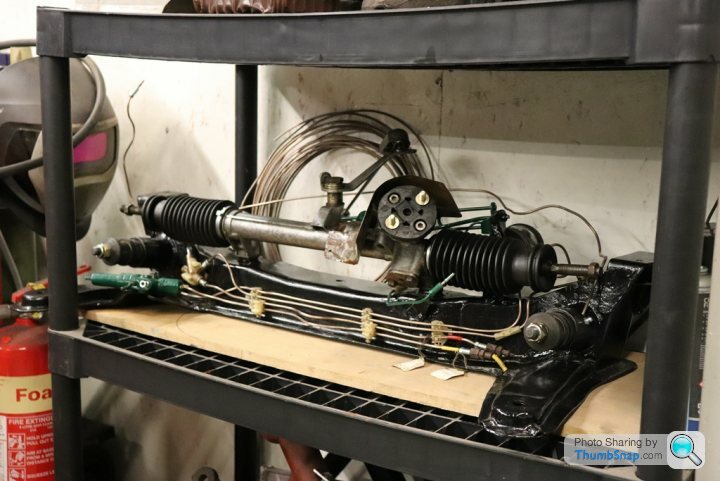
It's not finalised or perfected, but it's ready to go back on the car. Which is nice, because I haven't actually touched the car for about 3 years. Next job, dig it out from its pit!
(apologies if this is a bit hap-hazardly written, as I'm filling it in inbetween actually working!)
Anyway, I'm pleased to report things with the BX TRS are good. There have been some ups and downs (including the suspension), but on the whole, it's been a positive period.
So, back in October, I was still pratting around with that front subframe (did I mention it's a rare one?! Oh.) The fabrication and repair work was now done, but as it sat, it was a bare subframe, and that wouldn't be much use. I therefore decided to repopulate it with the various componentry that used to live there.
The bearings were already in place, but I knew the most time consuming piece was going to be the pipework. Despite my line of work as a sort-of-restoration-guy, I hadn't done much pipework on Citroens before. It was one area I'd never really had to address in all the years of knobbing about with them, but, I'd repiped the brake, clutch and fuel circuits on plenty of TVRs, so I figured that as the Citroen flares are normally easier to do, and the pipe thinner, that it should be a piece of cake in comparison. And, it was! Sorry, no jeopardy here.
To begin with the pipework, I needed to have ready all the components the pipework routed to. As this BX doesn't have power-steering (a blessing to my timescales), I didn't have quite as much fart around with as I otherwise might have done. But, I did have the majority of pipes to sort, as most of the originals were rotten clean through...or away entirely!

Later BXs used a black plastic coating around the pipework for added corrosion resistance, but earlier cars like this mk1 made do with bare steel. It was a good quality steel, sure, but it was steel all the same. The blustery Welsh coastline had clearly proven too much!
But now, it was time to start getting dirty, rusted parts of unknown servicability (that I'd removed about 3-4 years ago) together, and seeing what went where!
The first part, was the hydraulic safety/security valve. On a hydropneumatic Citroen, the majority of the system is simply hydraulic. The pneumatic element only comes into play when you get as far as the springing of the car, so unless you're dealing with spheres, it's hydraulic.
Everybody seems to act like they're too complicated, but that's only if you're ignorant. If I can grasp it, anybody can grasp it! Some green blood (aka LHM) sits in a reservoir (a round green metal one mounted in the offside inner wing), where it is drawn through a rubber hose by the high-pressure pump, and compressed until it's very, very fizzy (about 1400psi fizzy).
Once it's fizzed up, it's directed through a large-bore (6.5mm I.D.) metal pipe. On a car with power steering, it goes through a priority valve for this first, but being as this car doesn't have that, we'll keep it simple! So, at the other end of this metal pipe, is the pressure regulator (the thing that goes pssshhhh-tick every so often). This sits on front of the gearbox, and has a green sphere (or rust-coloured sphere, in my case) screwed onto it, like you would an oil filter. The pressure regulator allows the pressurised LHM through a small port and into the sphere. The sphere itself is very similar to that you'd find on end of one of the wheels, but its role is slightly different; It's basically a small but very strong balloon!
Imagine you have a generic balloon, the mouth of which is inserted onto a tube to allow the balloon to exhale. There's no knot, just your finger and thumb acting as a human 'tap' (so you could release it slightly and let the balloon down....and make funny squeaking noises!) But in this case, rather than blowing it up conventionally, it's got it's own supply for the air you pump, which goes in somewhere else, not the mouth of the balloon. So, the following alternative theory isn't exactly how it works, but it's the simplest way to imagine it (making this up as I go along):
- Your leg = the engine
- Footpump = hydraulic pump
- Pressurised air supply direct to balloon = pressurised LHM from the engine-driven pump
- Balloon = accumulator sphere
- Four small balloons = suspension spheres
- Four noisy whistles = the brakes
- The pinching action of your finger and thumb = the pressure regulator
- The tube the balloon is mounted on = the circuit to the safety valve
- The safety valve = your boss
However...there are also four smaller balloons in each corner of the room, which are all at the end of the pipe your balloon is stretched onto, and they also need to be regulated to a certain size. You have to inflate those by momentarily releasing and then reapplying your grip on your balloon, which in turn inflates those balloons a bit (and makes a 'psshhh-tick' noise), but of course, that also flattens your balloon in the process.
Annoyingly, every now and then, someone who calls themself Mr Bump comes along and tries to jump on those four balloons, at completely random intervals. What a knob! So now, you're probably going to have to keep pumping more often, and releasing pressure when you need to. How tiring!
And then, on top of this, there are four whistles. For some reason, these whistles are deemed to be very important, and although nobody is jumping on them, you are told that, occassionally, these whistles need to...well, whistle, and loudly! You don't have to worry about operating them, but you do have to make sure they have a sufficient supply of air that they'll actually make a noise when somebody else does.
So now, your easy job has become complicated. Your boss has come along and informed you that, to help, they'll divert the pressure to the whistles and the four balloons independantly, so that one doesn't affect the other too much. All you need to do is keep the pressure up.
However, if you don't keep the pressure up, the boss is going to stand on the pipe that goes to the whistles (so that they hold pressure briefly long enough to be blown for a short while longer), and forgets about the pipe that goes to the four balloons. These go flat, and the idiot Mr Bump can jump on the hard ground as much as he wants.
Then the boss informs EVERYBODY that you've let the pressure down, with a big red stop light.
I'm not smoking something, honest! That's just the easiest way to imagine it. I might go and give the pump and the regulator a quick cuddle now...that's a quite a s
 t life
t life 
Anyway, back to reality, and this little valve is the first port of call from the green blood, once it's been whizzed up to around 1400psi, and released by the pressure regulator.
There's a sprung valve inside, which requires a minimum set pressure to operate (the minimum set pressure the car can operate). If the pressure coming from the regulator (which on a healthy system has pretty much just been stored in the accumulator sphere) is sufficient, the spring is overpowered, and the valve remains open to both the brake and suspension circuits. Happy days.
However, if there is a drop in pressure (due to the engine dying and the pump stopping as a result, for example) as soon as it becomes lower than the pressure of the circuit, the valve slams shut and isolates the pressure in the braking circuit with everything that the accumulator had left. It also throws on the STOP light (which is what the little sensor is for). So, if you lose the engine, or the hydraulic input from the pump/regulator, maybe even down to a snapped belt, you've still got enough braking pressure left to halt the car safely. The suspension has to make do with whatever it had left, but a bumpy car you can stop is better than a smooth car that you can't.
So, let's meet the little valve (aka The Boss):

In this image, I've unwound the cap that holds the spring in position, and with it removed (having retreived the spring after it shot off across the workshop at tremendous speed):

Now, it's all manky and rusty because the wicked Welsh climate has had its wicked way with it over the past three decades, but as you can see, there is a hole in the top. That isn't actually meant to be a hole, it's meant to be a spigot. There is still a hosetail for this spigot, but sadly it's lodged in the end of a very old and brittle rubber hose. Balls.
The purpose of the hose is a return to the reservoir. Anything the safety valve deems unneccessary goes back to the tank (or onto your driveway, if you've got a leaky hose).
Citroens have long utilised this design, which CX, GS and even DS models employing a near-identical component, but during the time of the BX's reign, some clever dick suggested they used a strong type of plastic for the cap instead, as that wouldn't rust. And, they were right; they didn't. But, the plastic looks wrong for an early BX, and being the anal sort that I am, I decided I wanted to keep it looking OE. I put a call to arms out in the Citroen community, but I didn't have much patience (not that any offers came back anyway). Loath to fit one of my plastic spares, I set about repairing the old one. That's the whole ethos of this car - repair and reuse, not replace. I want it as original as possible.
To put this into effect, I went routing around in some old boxes, and found this old hosetail, pictured on the left:

The cup of tea isn't relevant, that was just...I was thirsty.
The washer is relevant, though. The metal cap had rusted and lost a lot of weight at the end. The sides were a bit pitted, but still plenty tough enough. The end, though? I wasn't totally confident the spring wouldn't just pierce through the end! That's where the washer came in.
I drilled out the rusted remains of the original spigot, so that the replacement would fit through the hole snugly...

Then I cut down the hose tail until it was almost just a pipe! I left a bit on the end to locate in the hole in the cap:


Then, I pushed it through the hole from the bottom, and clamped the new spigot in place:

A quick tack-weld later:

Then the washer came into play, to give it some strength back:


Seems like a lot of work for such a small component on an old car, doesn't it?!
Anyway, some primer later...:

And it was ready for many coats of not-quite-Citroen's-original-LHM-green-but-something-close-to-it-from-the-RAL-chart:

With the security valve reassembled and painted, I realised there weere other items that needed attention. I've also just realised that I've lost some pictures, so cannot document the new 'hardy' disc (rubber coupling between steering column and rack) that I fitted, or the cleaned up height-corrector, or the cleaned up steering rack....there's loads.
Anyway, in this image, you can see the old rack boots had been removed, the racks cleaned and greased, and the new hardy disc just visible near the top. The old one had totally split!

And in the meantime, I'd received new OMGcarpartsindapostgoodness from Autodoc, which is always a nice thing. It's the closest thing we have to the memories of unwrapping gifts at Christmas time as an excited child.

The new steering rack boots were contained within, along with a sum total of parts amounting to 180% more than I'd paid for the car.
This included:

Track rod ends! My intentions had always been to hunt out the OEM options for any spare parts for this car, and Autodoc is a great site to do that on. Luckily, my BX is a great car to do that on, too, as the majority of it is as it left the line at Rennes! This means I know, for example, that the OEM for the steering rack boots was Continental.
Now, the track rod ends weren't yielding any clues, and they may well not have been original anyway, but I put my old partsman hat back on, and went for the best available brand I could. In this case, it was Monroe (or, what purported to be Monroe - you never know these days, like with Pagid or TRW). Given the options (and given that I discovered that First Line's supplier is the same as Sasic - I avoided those!), Monroe was the best of a bad bunch.
I had a phone call from a German fellow a day later, asking "Vot iz diz peace of sheet you arrgh buying diz part vor?" Not really, he didn't.
He said that there was only one Monroe part in stock, and that the opposite side would have to be a different brand. I took a punt on an 'ABS' item, and got a partial refund. When they arrived, I was elated to discover that they were, in fact, the same part! Happy days!

These were duly painted in my magic gloss black stuff that I paint pretty much anything I come into contact with:

And eventually, all my work on this b
 d subframe culminated in something I could actually use!
d subframe culminated in something I could actually use!



It's not finalised or perfected, but it's ready to go back on the car. Which is nice, because I haven't actually touched the car for about 3 years. Next job, dig it out from its pit!
While we're on LHM theory, the BX had an interesting rear brake setup.
The front and rear were on individual circuits and the rear was cleverly variable using the pressure in the rear suspension spheres so that the amount of braking on the back would vary depending on load (and weight transfer). Even before ABS it would reduce the chance of locking up the rear wheels (and with the 1400psi or whatever it was a BX will happily lock up all wheels with very little pedal pressure) while making the most of the brakes.
Driver on his own? Mostly front brakes with only a smidge of rear.
Full car with boot full? Lots of rear brakes along with the front brakes.
There is a load more detail here http://www.citroenet.org.uk/miscellaneous/hydrauli... (and here http://www.citroenet.org.uk/miscellaneous/suspensi... )
Down side in practical terms mind was that the rear brakes hardly ever got a look in and the disks tended to need replacing due to rust long before they wore out!
The front and rear were on individual circuits and the rear was cleverly variable using the pressure in the rear suspension spheres so that the amount of braking on the back would vary depending on load (and weight transfer). Even before ABS it would reduce the chance of locking up the rear wheels (and with the 1400psi or whatever it was a BX will happily lock up all wheels with very little pedal pressure) while making the most of the brakes.
Driver on his own? Mostly front brakes with only a smidge of rear.
Full car with boot full? Lots of rear brakes along with the front brakes.
There is a load more detail here http://www.citroenet.org.uk/miscellaneous/hydrauli... (and here http://www.citroenet.org.uk/miscellaneous/suspensi... )
Down side in practical terms mind was that the rear brakes hardly ever got a look in and the disks tended to need replacing due to rust long before they wore out!
Love this thread!
Dont suppose you go this car from Glasgow? My mate was offered a red bx estate back in October which we nearly bought as something different to go to retrorides. It had been off the road for years and from memory had no keys or logbook
Edit; it still resides where it was
Dont suppose you go this car from Glasgow? My mate was offered a red bx estate back in October which we nearly bought as something different to go to retrorides. It had been off the road for years and from memory had no keys or logbook

Edit; it still resides where it was

Edited by rickygolf83 on Friday 17th January 16:45
Back in my RAF days, I was an engineer on Tornados. My Sergeant had a few of these and a CX Turbo. He rebuilt the hydraulics using Tornado parts and proved the system would run on aircraft hydraulic oil, OM15. Its civvy equivalent is Shell Fluid 31. Anyways, bit of useless info for you there.
Loving this thread (much like the rest thread of your dad's BX).
As I mentioned on that thread, my first car was a red 16 TRS (B 675 SHP) bought around Sept 1992. The earlier photos of the 'starship enterprise' dash on this one brings back many memories. Still think that car was the smoothest riding car I've ever owned /driven.
As I mentioned on that thread, my first car was a red 16 TRS (B 675 SHP) bought around Sept 1992. The earlier photos of the 'starship enterprise' dash on this one brings back many memories. Still think that car was the smoothest riding car I've ever owned /driven.
Admittedly, I'm a very long behind with this thread, so shall do my best to bring things up to speed before I go home, as I'm waiting for some paint to go off!
So, up to now, I have a painted, rebuilt subframe sat waiting for me on a shelf. Having spent hours farting around painting track rod ends, it dawned on me that readying some wishbones might prove a sensible use of time, being that they effectively connect the front wheels to the car.
Here's a wishbone:
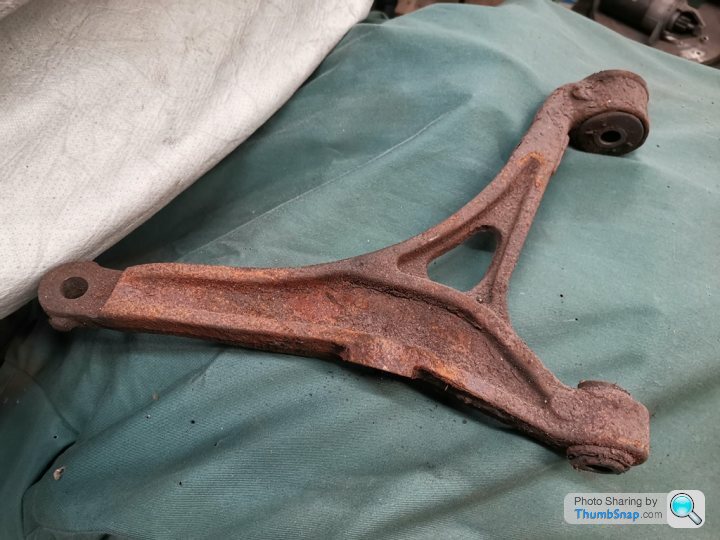
Those who've been paying attention (and I wouldn't blame you for not doing so) will recall that this is a very early bearing subframe-car...I may have mentioned that once or twice before. Being such means that unlike a normal BX, you cannot follow standard protocol, i.e:
As fortune would have it, SKF knew what kind of woes would present themselves to me at this juncture, and had to forethought to include a new set of bushes in the bearing kits that I fitted in the subframes. I think that's fantastic customer service, personally. More companies should look into the future, and predict s t that hasn't happened yet.
t that hasn't happened yet.
So, I had bushes, and I had wishbones. However, the existing bushes in the wishbones had been in there since 30th November 1983, and the bulk of that time was spent in Swansea. If I were a bush in Swansea, I'd be anchoring myself in there pretty tight.
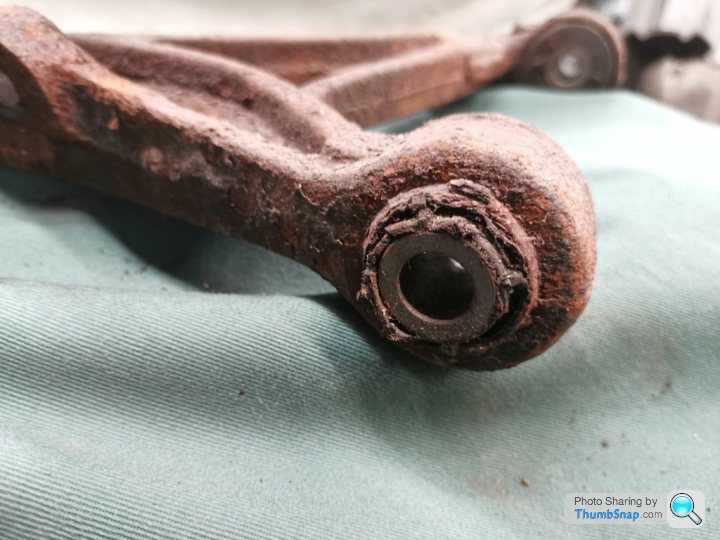
Not looking clever, is it? That's got headache written all over it.
Luckily, I have a 30tonne press at my disposal, but left to its own devices it would have no issue in snapping a flimsy BX wishbone in half. For that reason, and because I knew I'd be exterting more than a couple of grunts, I rigged up some bracing to support the wishbone enough to really lean on it.
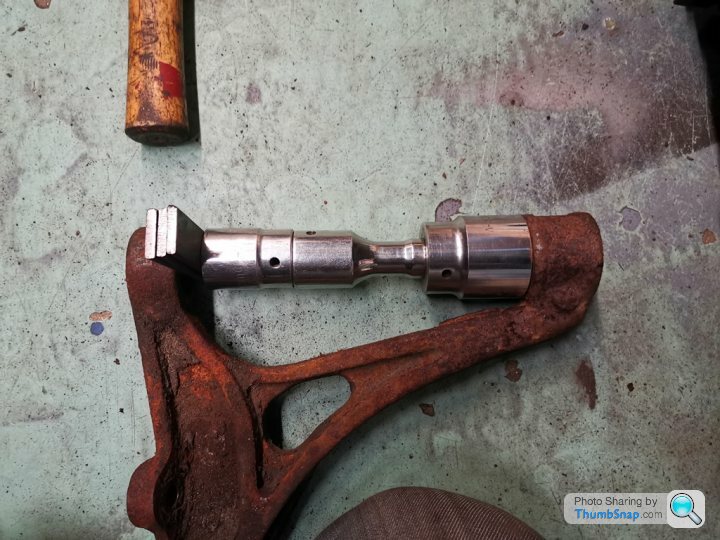
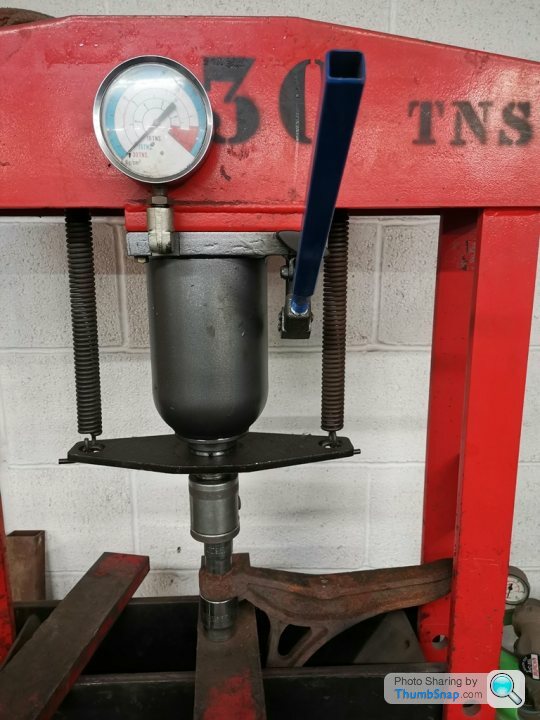
(The picture in the press is the side that didn't need the bracing, but I took a picture of the wrong piece of action. Bite me! I'm no pro....)
Fully expecting to have to exert all of the available 30tonnes, I prepared myself for the shock and subsequent BANG that would follow when either the bush gave way, or something old, rare and unobtainable broke by adopting the face Rowan Atkinson did in the episode of Mr Bean where he accidentally anesthetised his dentist (played by Richard Wilson, who didn't believe it) and had to perform his own filling. The bit where he's drilling: that face.
My efforts to bring spare underwear to work, however, proved...well, pointless. Because, much to my amazement, there was no BANG; nor shock, or shudder:
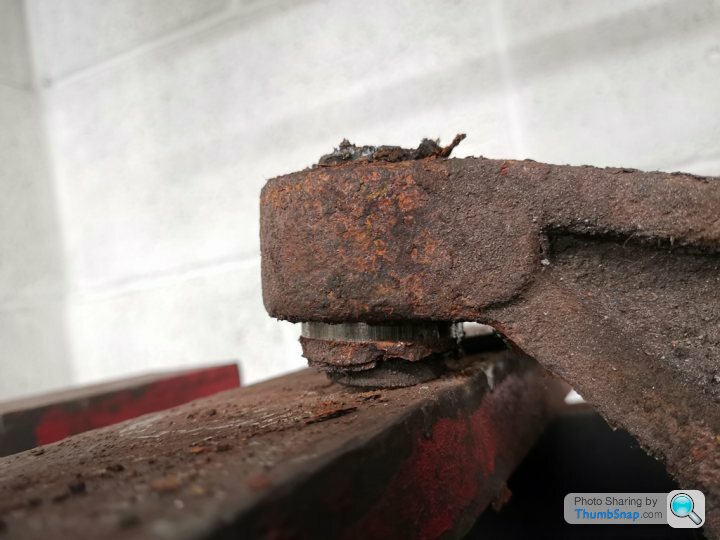
It just pushed out. All of them did.
It was dead easy, true, but do you like how I injected some jeopardy there? How I captivated you? How I made it all 'edge of the seat' reading? Because that's how they do TV, that is. It must be amazing to watch me at work here! You're all very lucky.
So, having wasted many, many words basically conveying that I've removed four wishbone bushes from a pair of wishbones, I prepped, painted and re-bushed them. In the process of doing this, I completely forgot to take any pictures, but use your imaginations. They ended up all black, and shiney.
They were refitted to the subframe, which was now ready to be reattached to the car....
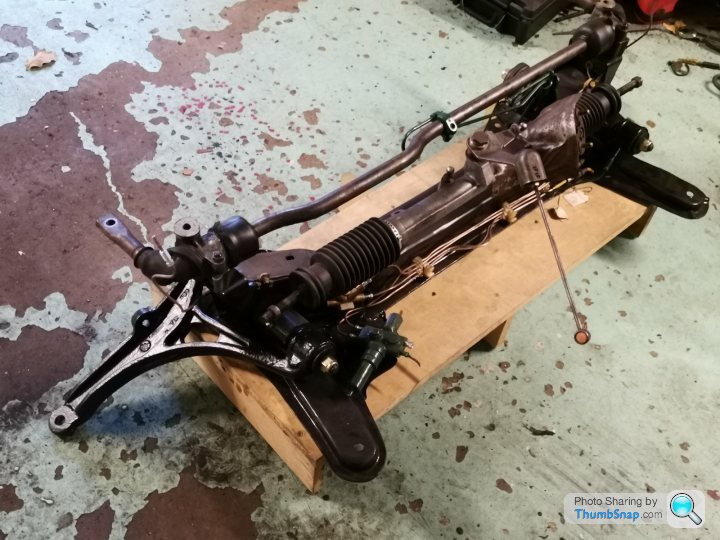
...which was immobilised, perched on four axle stands on the other side of the workshop, having resided there for at least some years...
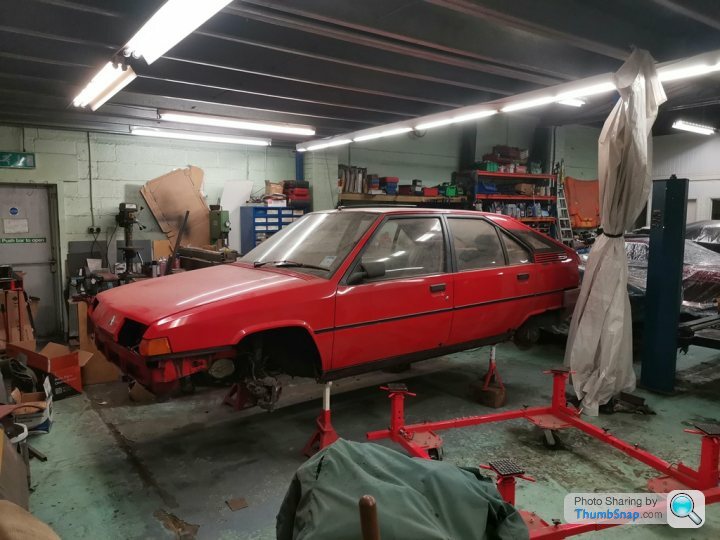
I placed it on that trolley thing, and wheeled it over to the two-post ramp. It all went very easily, with no further jeopardy, or drama. I definitely didn't have to remove the limit-stop switch on the four-post ramp to allow it to raise about 1cm higher so that it would clear the aerial, and I certainly didn't have to do that because I steadfastly refused to remove the aerial as that would involve disturbing the original fixings that house the interior light, because it's so original and all the other boring stuff I harp on about.
(The fact that it doesn't even have a radio is a somewhat ironic addition to the tale)
Anyway, ramp reached afew hours short while later, I was ready to move on to phase two.
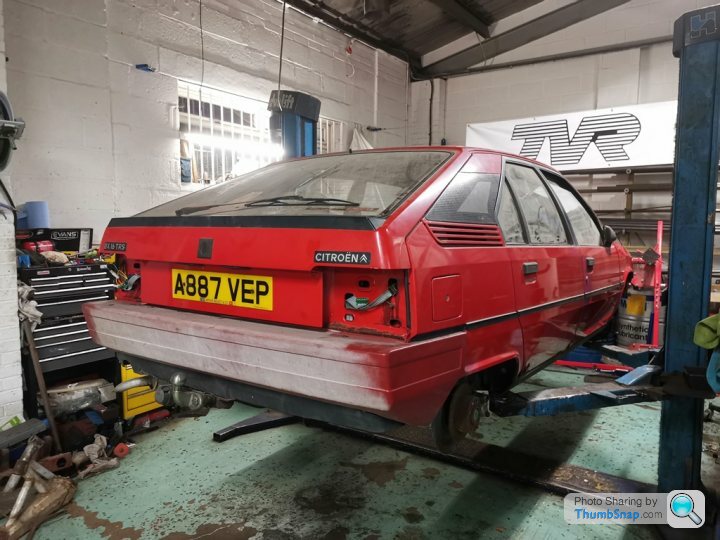
...which I will have to add later, as once again I've waffled and run out of time.
So, up to now, I have a painted, rebuilt subframe sat waiting for me on a shelf. Having spent hours farting around painting track rod ends, it dawned on me that readying some wishbones might prove a sensible use of time, being that they effectively connect the front wheels to the car.
Here's a wishbone:

Those who've been paying attention (and I wouldn't blame you for not doing so) will recall that this is a very early bearing subframe-car...I may have mentioned that once or twice before. Being such means that unlike a normal BX, you cannot follow standard protocol, i.e:
- Pop into Euro Car Parts.
- Be looked at blankly when trying to explain what a Citroen BX is.
- Then be looked at blankly while you try to explain what a wishbone is.
- Give up, go home and find some complete wishbones on eBay for next to nothing.
- Smash forehead with a rusted suspension sphere when you clock the invoice has come from 'Euro Car Parts Ltd'.
As fortune would have it, SKF knew what kind of woes would present themselves to me at this juncture, and had to forethought to include a new set of bushes in the bearing kits that I fitted in the subframes. I think that's fantastic customer service, personally. More companies should look into the future, and predict s
 t that hasn't happened yet.
t that hasn't happened yet.So, I had bushes, and I had wishbones. However, the existing bushes in the wishbones had been in there since 30th November 1983, and the bulk of that time was spent in Swansea. If I were a bush in Swansea, I'd be anchoring myself in there pretty tight.

Not looking clever, is it? That's got headache written all over it.
Luckily, I have a 30tonne press at my disposal, but left to its own devices it would have no issue in snapping a flimsy BX wishbone in half. For that reason, and because I knew I'd be exterting more than a couple of grunts, I rigged up some bracing to support the wishbone enough to really lean on it.


(The picture in the press is the side that didn't need the bracing, but I took a picture of the wrong piece of action. Bite me! I'm no pro....)
Fully expecting to have to exert all of the available 30tonnes, I prepared myself for the shock and subsequent BANG that would follow when either the bush gave way, or something old, rare and unobtainable broke by adopting the face Rowan Atkinson did in the episode of Mr Bean where he accidentally anesthetised his dentist (played by Richard Wilson, who didn't believe it) and had to perform his own filling. The bit where he's drilling: that face.
My efforts to bring spare underwear to work, however, proved...well, pointless. Because, much to my amazement, there was no BANG; nor shock, or shudder:

It just pushed out. All of them did.
It was dead easy, true, but do you like how I injected some jeopardy there? How I captivated you? How I made it all 'edge of the seat' reading? Because that's how they do TV, that is. It must be amazing to watch me at work here! You're all very lucky.
So, having wasted many, many words basically conveying that I've removed four wishbone bushes from a pair of wishbones, I prepped, painted and re-bushed them. In the process of doing this, I completely forgot to take any pictures, but use your imaginations. They ended up all black, and shiney.
They were refitted to the subframe, which was now ready to be reattached to the car....

...which was immobilised, perched on four axle stands on the other side of the workshop, having resided there for at least some years...

I placed it on that trolley thing, and wheeled it over to the two-post ramp. It all went very easily, with no further jeopardy, or drama. I definitely didn't have to remove the limit-stop switch on the four-post ramp to allow it to raise about 1cm higher so that it would clear the aerial, and I certainly didn't have to do that because I steadfastly refused to remove the aerial as that would involve disturbing the original fixings that house the interior light, because it's so original and all the other boring stuff I harp on about.
(The fact that it doesn't even have a radio is a somewhat ironic addition to the tale)
Anyway, ramp reached a

...which I will have to add later, as once again I've waffled and run out of time.
Gassing Station | Readers' Cars | Top of Page | What's New | My Stuff



